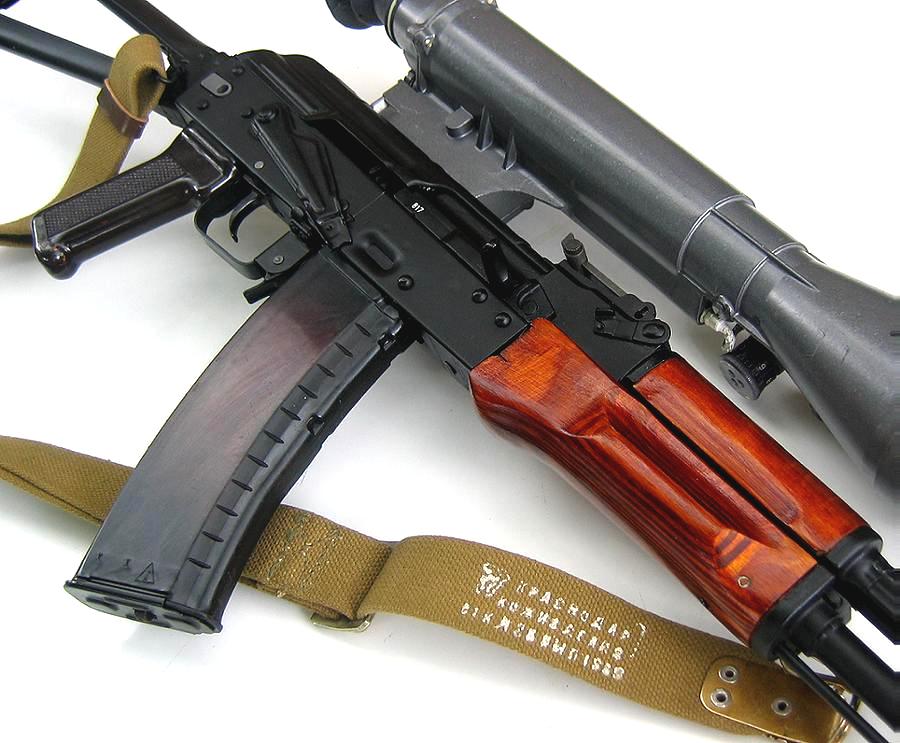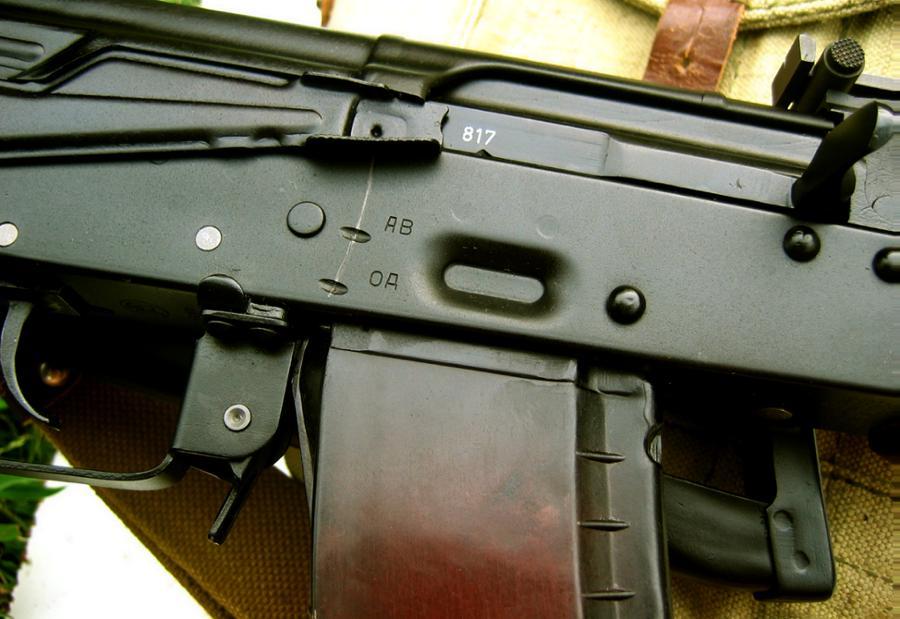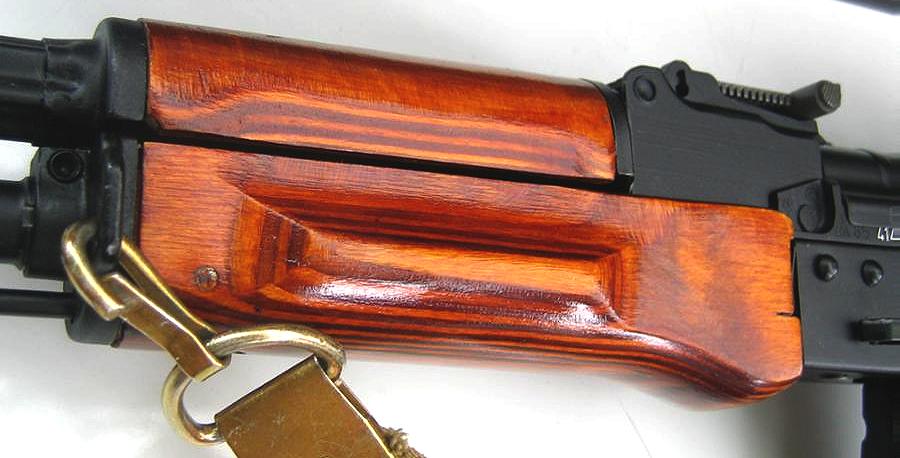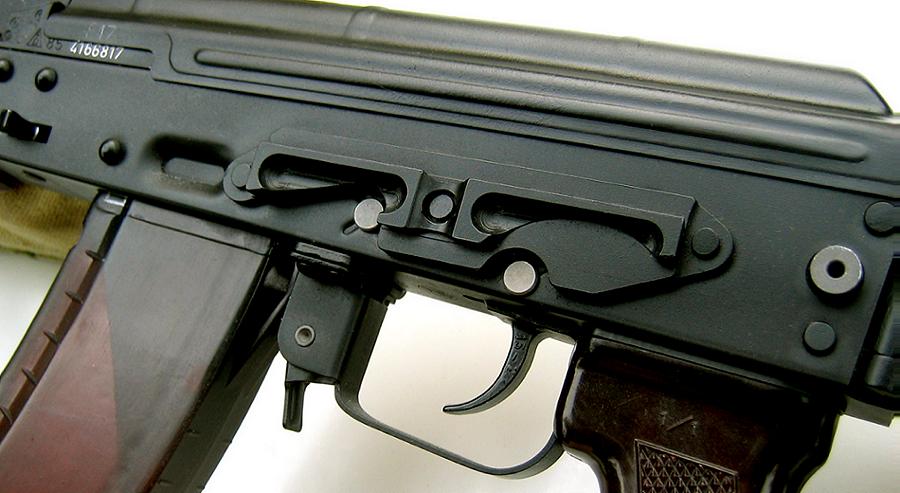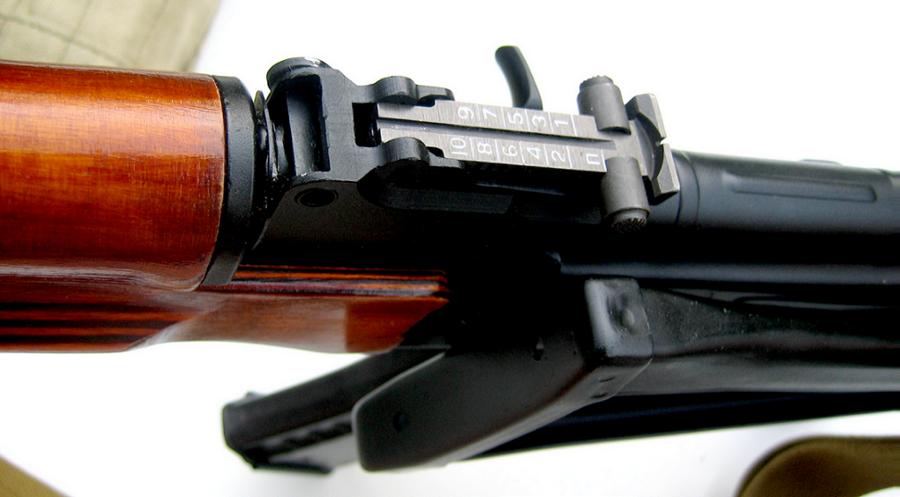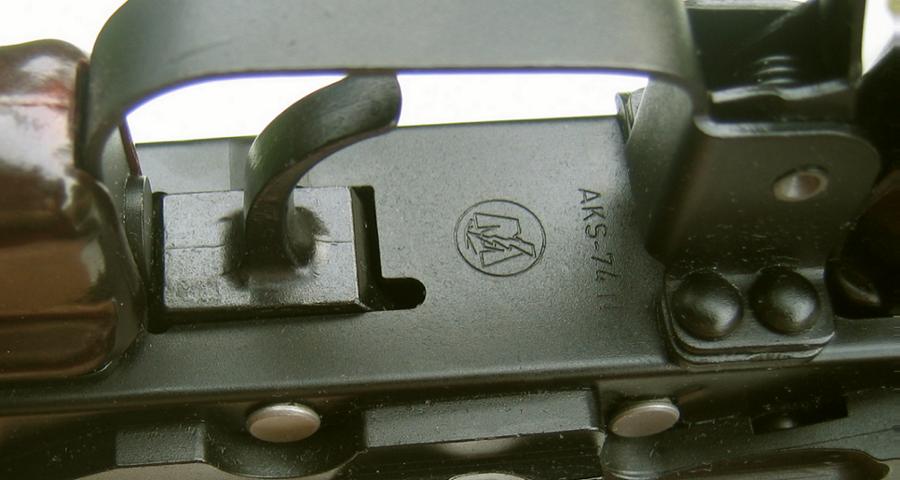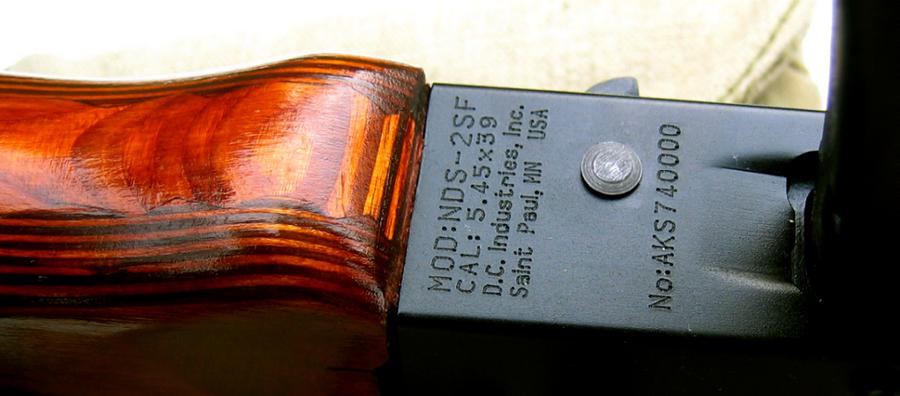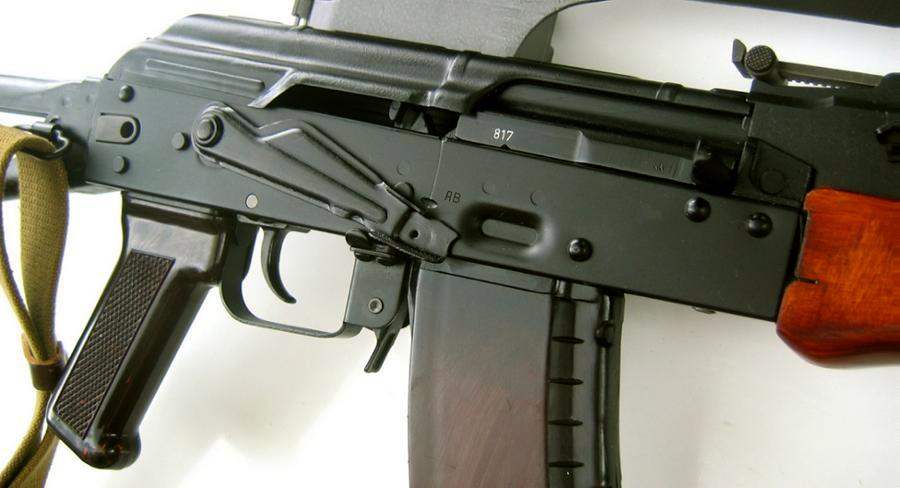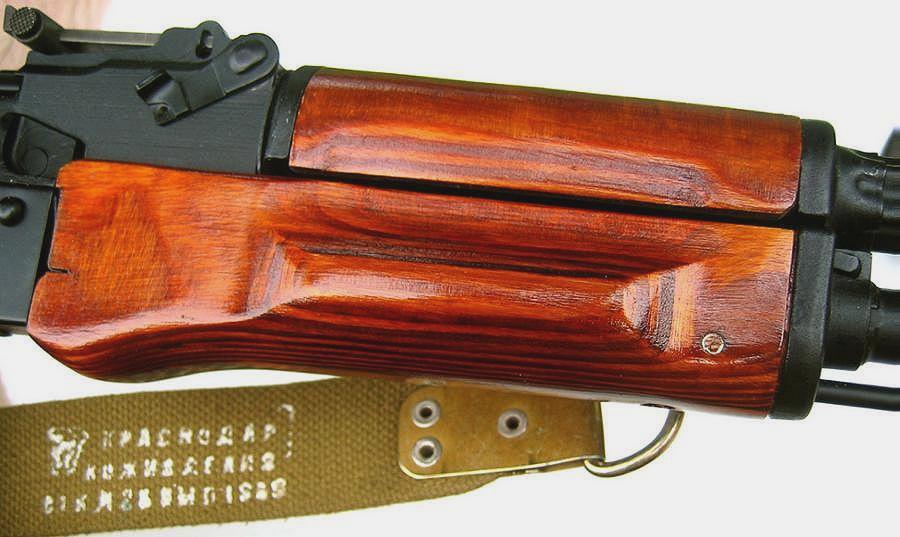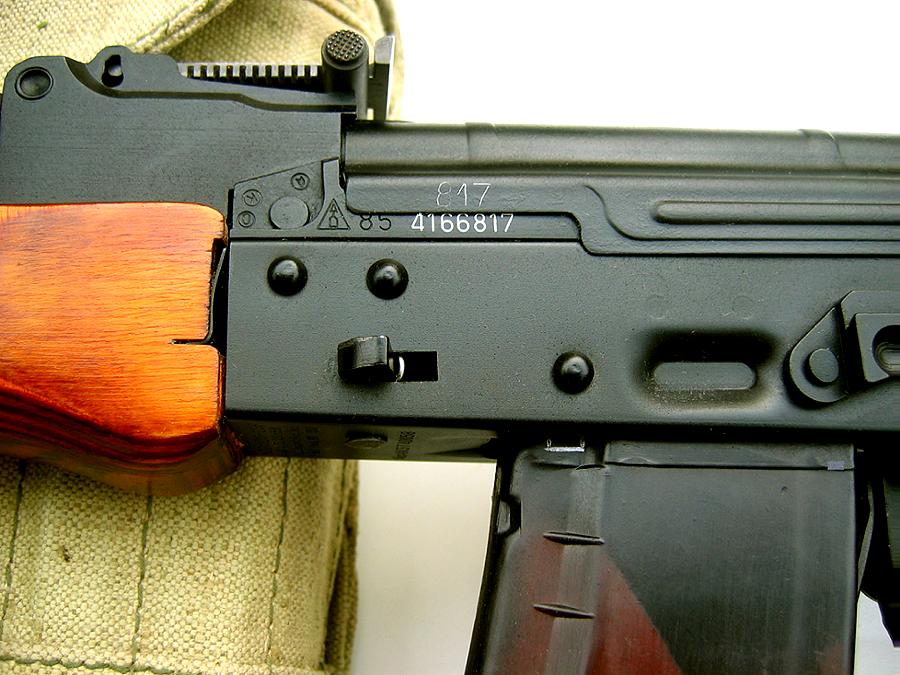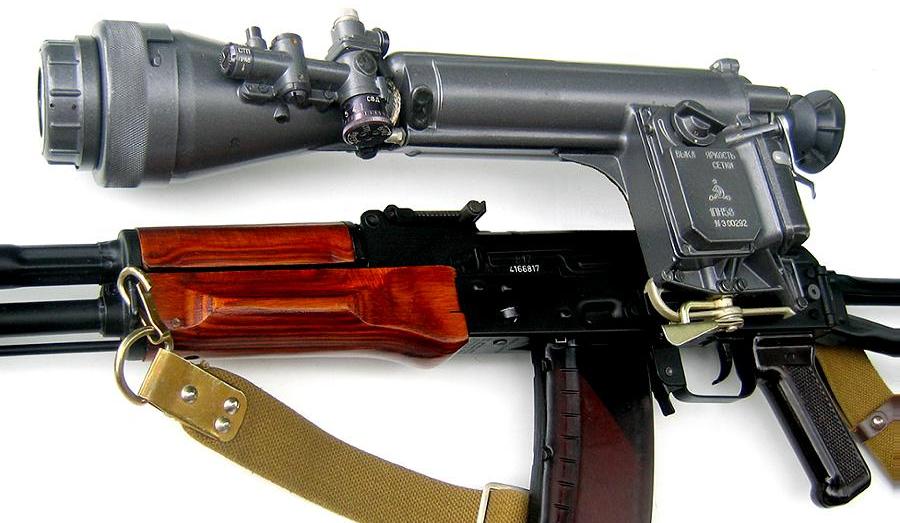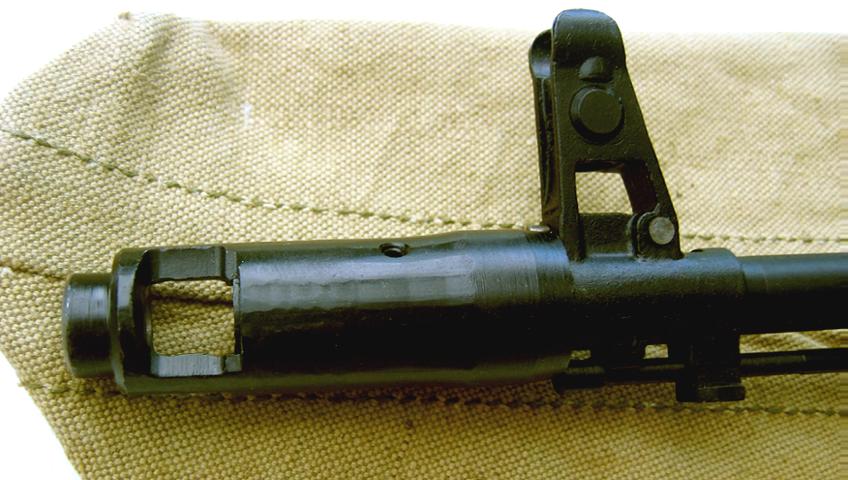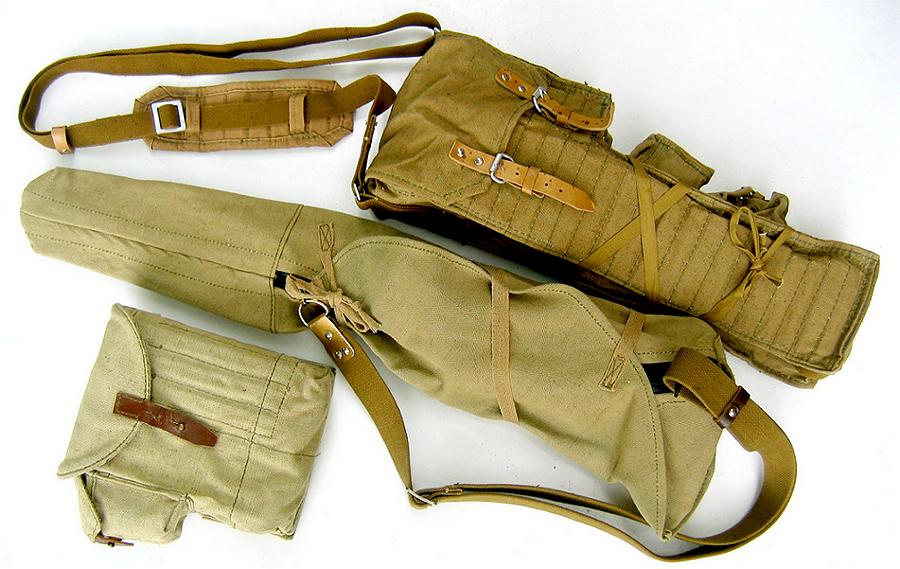AKS-74N2 circa 1985
Izhevsk Arsenal (DCI-based Replica)
A Study of Mid-War Kalashnikovs
That's not to say we have never found images of an example or two, but the year codes were never visible. Even European-based acquaintances, with whom we owe a great debt to for their contributions to this study (most notably R. Stott) have commented on the fact no 1985 dated AK-74's seem to exist in the public museums or private collections they have visited. Considering the rarity of good images, that may not mean much since information we have on some years of production are based on only one or two "documented" examples.
Having said all this in introduction, I wish to present to our readers an excellent example of a replica Soviet AKS-74N in semi-automatic form, it's features based on what we feel are the most accurate information available on this particular era of the Izhevsk arsenal production, at the height of the Afghan war. The principal assembly work was performed by Ted Marshall of Marshall Arms, using the outstanding side-folding AK-74 receiver developed and manufactured in the United States by DC Industries.
The basic overall form of the rifle goes back to at least 1982, which saw the introduction of many of the parts designs we see today on the modern Kalashnikov. Bulgaria started their domestic assembly of AK-74 rifles in 1982/83 using parts kits supplied by Russia. This cooperative effort turns out to be very important to the modern collector because we can trace the Bulgarian AK-74 parts easily acquired today to the 1982 Soviet example. Such a direct copy with few domestic changes, in some cases probably stamped on transferred Soviet tooling, has provided an important source of parts. In fact, many of the earliest parts kits imported into the west from Bulgaria contained some Soviet-made items. Other than the solid wood furniture, the Bulgarian AK-74 is a direct copy of the typical 1982/83 Soviet model.
Soviet assistance continued throughout the 1980's, but the basic design that was placed into production within Bulgaria itself seemed stuck in time without change, and that time was 1982. In contrast, production changes continued to roll along at Izhevsk at a fast pace, where great numbers of AK-74 and AKS-74 rifles were being assembled to supply front-line troops deploying to the Afghan sandbox.
In the case of the subject rifle, it was build using a Bulgarian parts kit supplemented with a few rare Russian-made parts to update it towards the 1985 standard. A number of US-made parts, carefully modified for cosmetic accuracy, were included as required by federal regulations.
The DC Industries receiver has excellent "magazine dimples" which beautifully copy the shape and depth of the original Soviet receiver for this era. The spot welds that hold the bolt guide rails in place are also very nicely done with uniformly deep and rounded indentions. Also note the long, square style magazine catch release lever which was adopted in 1982. This style, with only a minor change to the shape of the central ribbing in 1989/90, continues in Russian production even today.
One of the beneficial reasons for choosing 1985 as a build year is the fact that this was the final year for the use of laminated wood on production Kalashnikov AK-74 rifles. Sometime during the 1985 production run, plum colored glass-reinforced polyamide plastic handguards and buttstocks began to be installed on production line AK-74's, joining pistol grips and magazines to complete an all "Plum" furniture set. At least one 1985-dated rifle has been recently found in Afghanistan with what certainly appears to be it's original polyamide furnishings. Since no 1986 rifle has been found using wood laminates, a 1985 rifle could theoretically be outfitted with either of the two furniture choices. It is possible that plum furnishings could have been used on the AKS-74 sooner than the fixed stock models, which were produced on separate assembly lines. Wood handguards may have been kept for use with wood buttstocks until supplies were depleted. On the other hand, wood handguards may have been used on the AKS-74 longer (if wood buttstocks ran out). Until we get a more complete serial number range for both models, there is no way to know for sure.
The rail used here was installed by Ted Marshall and is the RMP-3, a direct copy of the Soviet rail introduced in 1978. It is available on our products listing, and is a high quality US-made CNC machined unit. It is the most accurately styled optics rail available today for Soviet-based 1980's Kalshnikov rifle projects, and is a direct replacement for the Bulgarian rail found on many semi-automatic rifles. It is also correct for a German MPiAKS-74N/Wieger project, since this is the design the German's copied for their own domestic rifles.
Fro several years, Marshall Arms has been building what many experts consider the best quality Kalashnikov rifles available today. Combining extensive knowledge and attention to detail with high quality metallurgy skills, he hand crafts examples anyone would love to see in their collections. Although we in no way work for, or have financial connections with Mr. Marshall, many of his rifles have graced the pages of our web site. I guess this is chiefly because they have been received with such a high favor by the collecting community, and deserve the attention they garner publicly. We of course invite anyone to submit images and articles concerning builds done by any manufacturers. Please keep in mind that due to space limitations, only the best examples (or unique variations) of each type of build can be uploaded onto the web site.
The NDS-2SF is an amazing product. Our hats go off to DC Industries for the fine job they have done on these and other receiver products for the AK rifle series. The attention to small details and the overall quality of the properly heat-treated end product show in the final results of the build. We think the quality of this receiver proudly represents the series without compromise and would meet with the approval of M. T. Kalashnikov himself.
A few observations are in order here. Mr. Marshall has nicely engraved and highlighted the last three of the serial number on the carrier shoulder in Soviet fashion. This rifle also has the so-called 'lazy ribs" top cover which was introduced in 1982. Note how the ribbing seems to dissolve on the sides of the top cover. Earlier ribbed top covers had very manly, muscular-looking ribbing, with profound top and side contouring. As with all AK-74 and late AKM top covers, there is a shelf or rolled lip over the selector lever. Note also the use a "pistol grip receiver reinforcement plate" which was used on all Russian made sheet metal receiver folding stock rifles, except for the AKS-74U short-barrel rifle. The rifle uses a standard shiny plum-colored polyamide pistol grip, in this case a US-made copy of the Soviet pattern used for legal reasons. This style was placed into service around 1979 and used on all AKS-74 rifles up until a matte textured version became available in 1987/88 to match the new plastic ribbed handguards that came out on mid-year 1985 or early 1986 production rifles.
Ammunition feed is via an era-correct glass-reinforced Polyamide-6 material "plum" 30-round box magazine, which was introduced as early as 1981/82 but much more commonly fielded by 1984/85. It was definitely the magazine issued with new models of AK-74 rifles in 1985, although the older bakelite versions were still being widely used even through conflicts in Chechnya throughout the 1990's.
Also take note of the extremely nice triple-cluster proof marks engraved onto the barrel pin pad. This ensemble is common to Kalashnikovs manufactured at Izhevsk at the time, each one stamped individually and representing a particular inspection point along the assembly line (examples might include headspacing, barrel pin installation, bolt guide rail/trunnion alignment, magazine fitment, etc.).
The hook installed in the center of the receiver wall is for locking the stock in the folded position. It is spring loaded (stays in the forward position) and must be manually actuated to release the stock. The stock can be locked into the folded position simply by snapping it across the face of the hook in a forceful fashion. Due to it's design function and interface with the buttstock, this part (and that of the stock) will show finish wear very easily.
Note the rear of the wood handguard has a spring clip which keeps it tight and free of movement. This allowed the designers to shorten the handguard slightly and allow spring tension to do what a time consuming hand fitting operation did for earlier wood handguards which had no spring. The spring also ensures wear will not loosen the handguard over the entire life of the rifle.
This close-up view also shows to good advantage the exceptional finish Marshall Arms has developed for Russian clone projects. It is truly a deep black with the correct amount of sheen and texture for a new rifle of this era. This is a task harder to accomplish than one might think. In many cases, the paint is often too flat or too gray to match a true Soviet finish, or too soft or fragile for real world use. I think the formula Marshall is using has really hit the nail on the head, so to speak.
By 1985, the upgraded model NSPUM (GRAU Index 1PN58) started to see service in Afghanistan. There is, however, no doubt that large numbers of older issue NSPU's stayed in service until the end of the war. The newer 1PN58 (seen above in the photo) used a much improved multi-tablet dry cell battery providing a total operating voltage supply of 6.25 volts. Although they are often confused, the NSPUM can be identified from the NSPU it resembles by the round battery compartment and the round optics tube. The NSPU has a sqaure battery compartment and an angled optics tube with a flat (or oval-shaped) central cross-section, but this is generally only observed in top view images. Using an advanced Generation 1+ cascade-type image intensifier, the 1PN58 also provided a brighter, higher contrast field of view while also being lighter in overall weight.
Mating a 1PN58 sight to the standard AKS-74N created an AKS-74N2 (GRAU Index 6P21N2). The sight is equipped with a universal optics clamp which allows it to be properly adjusted for a perfect fit to any individual rifle. This clamp will also fit all other types of Russian-based weapons with an optical mounting rail. In normal Soviet fashion, the NSPUM is slightly offset to the left of the rifle bore centerline and sits fairly high above the rifle top cover. Although several newer models have been produced, the 1980's technology 1PN58 is apparently still in production at Novosibirsk (NPZ) and available as an option with most small arms direct from the Izhmash Arsenal.
This style of smooth callar brake has the typical modern-style two-piece forward section (using a pressed-in bullet baffle), but can be specifically identified by the unique "faceted" (or scalloped) contouring evident along much of it's full length. This odd "whittled" look breaks up into small indentations as it gets closer to the muzzle. The threaded collar section is also shorter and much more rounded or smooth in appearance than later brakes, and thus it can be identified from the present day style which has a long, angular collar profile. Keep in mind that All Soviet AK-74 muzzle brakes have essentially the same overall length, except for the earliest "half-moon" types which had slightly shorter forward bayonet ring journals.
The magazine pouch is a four-cell design, and included an external pocket for an oil bottle and a cleaning kit. Internal slots can carry an unloaded 4-piece stripper clip set with loading adapter. Once the first magazine is removed and loaded into the firearm, the stripper clips can be loaded and placed into the front right pocket which is equipped with a leather strap to keep them secured.
The NSPUM (or NSPU) can be shoulder carried in an accompanying padded web case while on deployment, during parachute drops or on patrol. The case has pockets for additional voltage storage batteries, ballistic cam sets, cleaning accessories, extra rubber eyepieces, and desicant packs. It can also be placed, along with all of it's accessories, in a special sheet metal box (not shown) when it's use is not impending or when in long term arsenal storage. If the "complex" is originally matched from the factory, this metal transit case will be marked with both the serial number and model of the rifle as well as the scope.
I suppose I should comment on year dates as it pertains to new introductions, since it might be confusing to some people who may think there is a definitive and clear cut year-to-year timeline to discover here. To a point, there is, but be aware that it is almost impossible to pinpoint the exact start and stop of virtually every obscure parts design change. Since the factory never waited until 31 December to stop using Part A and start using Part B, we must characterize the transitions. Therefore, if we determine that Part A was used in 1983 on certified original rifles, and Part B was used in 1984, then the transition would be noted as 1983/84. Also, keep in mind the factory has a nasty habit of using both the older and newer design parts at the same time, even for a matter of years (thankfully for our discussion, this was more common in the preceding decades as most AK-74 design changes seemed to have been relatively quickly made).
RECEIVER: DC Industries